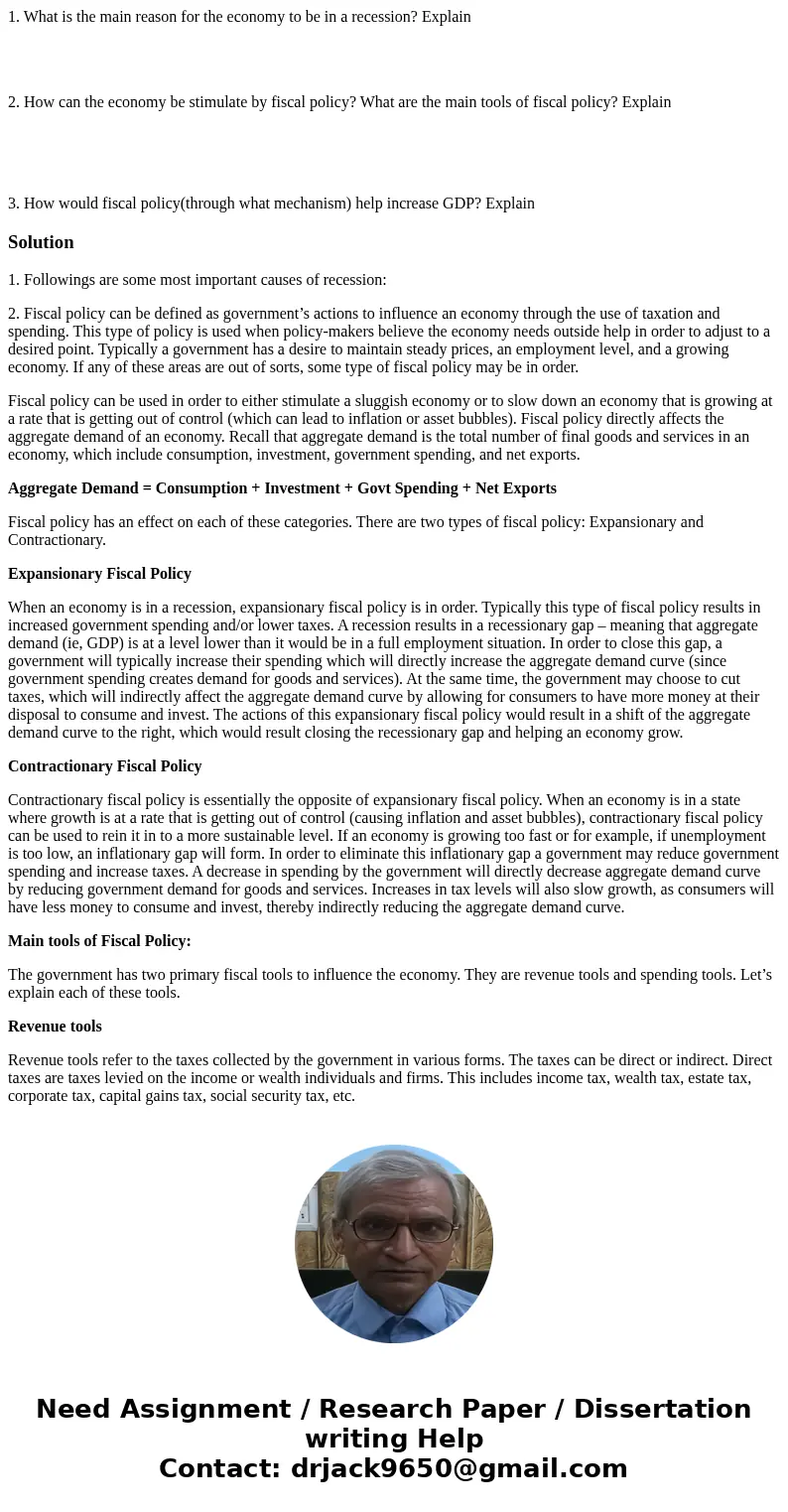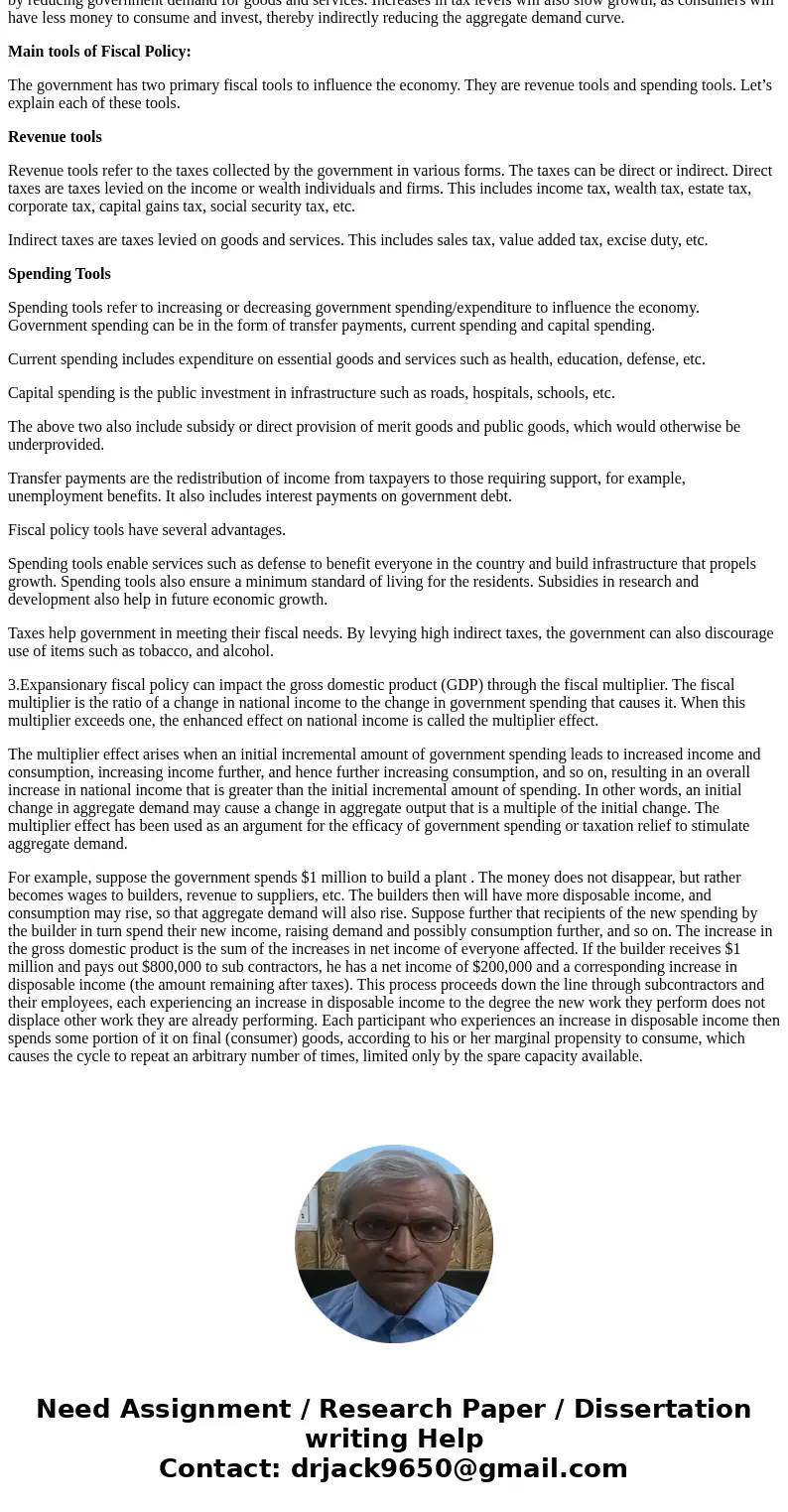1 What is the main reason for the economy to be in a recessi
1. What is the main reason for the economy to be in a recession? Explain
2. How can the economy be stimulate by fiscal policy? What are the main tools of fiscal policy? Explain
3. How would fiscal policy(through what mechanism) help increase GDP? Explain
Solution
1. Followings are some most important causes of recession:
2. Fiscal policy can be defined as government’s actions to influence an economy through the use of taxation and spending. This type of policy is used when policy-makers believe the economy needs outside help in order to adjust to a desired point. Typically a government has a desire to maintain steady prices, an employment level, and a growing economy. If any of these areas are out of sorts, some type of fiscal policy may be in order.
Fiscal policy can be used in order to either stimulate a sluggish economy or to slow down an economy that is growing at a rate that is getting out of control (which can lead to inflation or asset bubbles). Fiscal policy directly affects the aggregate demand of an economy. Recall that aggregate demand is the total number of final goods and services in an economy, which include consumption, investment, government spending, and net exports.
Aggregate Demand = Consumption + Investment + Govt Spending + Net Exports
Fiscal policy has an effect on each of these categories. There are two types of fiscal policy: Expansionary and Contractionary.
Expansionary Fiscal Policy
When an economy is in a recession, expansionary fiscal policy is in order. Typically this type of fiscal policy results in increased government spending and/or lower taxes. A recession results in a recessionary gap – meaning that aggregate demand (ie, GDP) is at a level lower than it would be in a full employment situation. In order to close this gap, a government will typically increase their spending which will directly increase the aggregate demand curve (since government spending creates demand for goods and services). At the same time, the government may choose to cut taxes, which will indirectly affect the aggregate demand curve by allowing for consumers to have more money at their disposal to consume and invest. The actions of this expansionary fiscal policy would result in a shift of the aggregate demand curve to the right, which would result closing the recessionary gap and helping an economy grow.
Contractionary Fiscal Policy
Contractionary fiscal policy is essentially the opposite of expansionary fiscal policy. When an economy is in a state where growth is at a rate that is getting out of control (causing inflation and asset bubbles), contractionary fiscal policy can be used to rein it in to a more sustainable level. If an economy is growing too fast or for example, if unemployment is too low, an inflationary gap will form. In order to eliminate this inflationary gap a government may reduce government spending and increase taxes. A decrease in spending by the government will directly decrease aggregate demand curve by reducing government demand for goods and services. Increases in tax levels will also slow growth, as consumers will have less money to consume and invest, thereby indirectly reducing the aggregate demand curve.
Main tools of Fiscal Policy:
The government has two primary fiscal tools to influence the economy. They are revenue tools and spending tools. Let’s explain each of these tools.
Revenue tools
Revenue tools refer to the taxes collected by the government in various forms. The taxes can be direct or indirect. Direct taxes are taxes levied on the income or wealth individuals and firms. This includes income tax, wealth tax, estate tax, corporate tax, capital gains tax, social security tax, etc.
Indirect taxes are taxes levied on goods and services. This includes sales tax, value added tax, excise duty, etc.
Spending Tools
Spending tools refer to increasing or decreasing government spending/expenditure to influence the economy. Government spending can be in the form of transfer payments, current spending and capital spending.
Current spending includes expenditure on essential goods and services such as health, education, defense, etc.
Capital spending is the public investment in infrastructure such as roads, hospitals, schools, etc.
The above two also include subsidy or direct provision of merit goods and public goods, which would otherwise be underprovided.
Transfer payments are the redistribution of income from taxpayers to those requiring support, for example, unemployment benefits. It also includes interest payments on government debt.
Fiscal policy tools have several advantages.
Spending tools enable services such as defense to benefit everyone in the country and build infrastructure that propels growth. Spending tools also ensure a minimum standard of living for the residents. Subsidies in research and development also help in future economic growth.
Taxes help government in meeting their fiscal needs. By levying high indirect taxes, the government can also discourage use of items such as tobacco, and alcohol.
3.Expansionary fiscal policy can impact the gross domestic product (GDP) through the fiscal multiplier. The fiscal multiplier is the ratio of a change in national income to the change in government spending that causes it. When this multiplier exceeds one, the enhanced effect on national income is called the multiplier effect.
The multiplier effect arises when an initial incremental amount of government spending leads to increased income and consumption, increasing income further, and hence further increasing consumption, and so on, resulting in an overall increase in national income that is greater than the initial incremental amount of spending. In other words, an initial change in aggregate demand may cause a change in aggregate output that is a multiple of the initial change. The multiplier effect has been used as an argument for the efficacy of government spending or taxation relief to stimulate aggregate demand.
For example, suppose the government spends $1 million to build a plant . The money does not disappear, but rather becomes wages to builders, revenue to suppliers, etc. The builders then will have more disposable income, and consumption may rise, so that aggregate demand will also rise. Suppose further that recipients of the new spending by the builder in turn spend their new income, raising demand and possibly consumption further, and so on. The increase in the gross domestic product is the sum of the increases in net income of everyone affected. If the builder receives $1 million and pays out $800,000 to sub contractors, he has a net income of $200,000 and a corresponding increase in disposable income (the amount remaining after taxes). This process proceeds down the line through subcontractors and their employees, each experiencing an increase in disposable income to the degree the new work they perform does not displace other work they are already performing. Each participant who experiences an increase in disposable income then spends some portion of it on final (consumer) goods, according to his or her marginal propensity to consume, which causes the cycle to repeat an arbitrary number of times, limited only by the spare capacity available.


 Homework Sourse
Homework Sourse